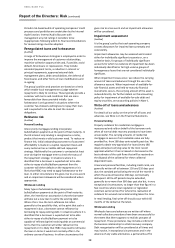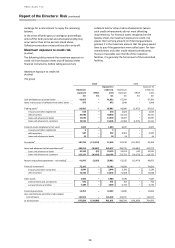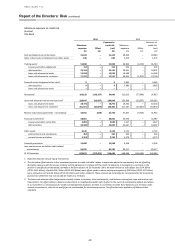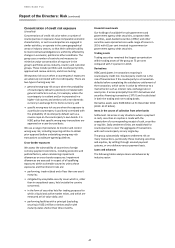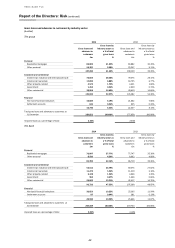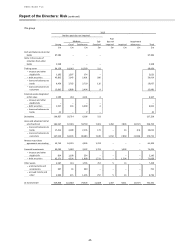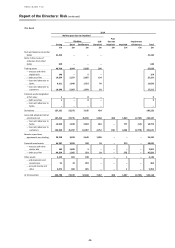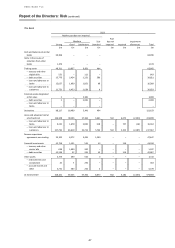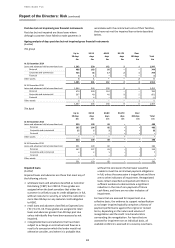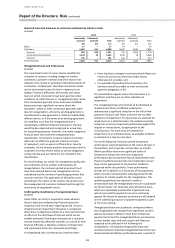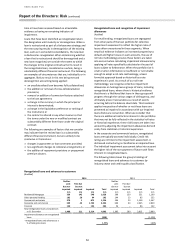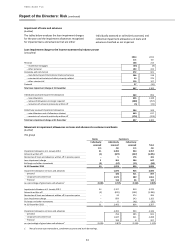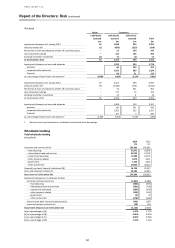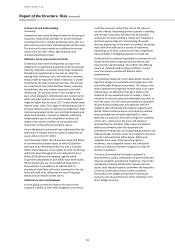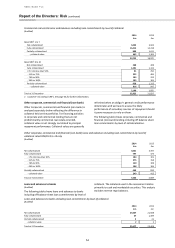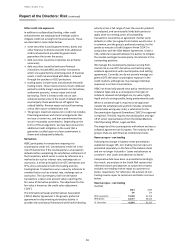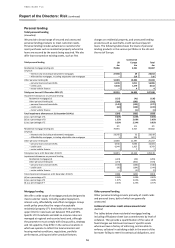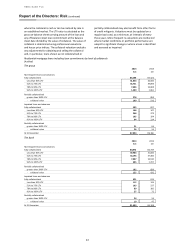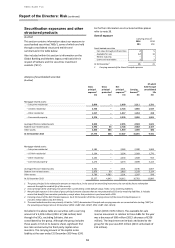HSBC 2014 Annual Report Download - page 50
Download and view the complete annual report
Please find page 50 of the 2014 HSBC annual report below. You can navigate through the pages in the report by either clicking on the pages listed below, or by using the keyword search tool below to find specific information within the annual report.
HSBC BANK PLC
Report of the Directors: Risk (continued)
48
Past due but not impaired gross financial instruments
Past due but not impaired are those loans where
although customers have failed to make payments in
accordance with the contractual terms of their facilities,
they have not met the impaired loan criteria described
below.
Ageing analysis of days past due but not impaired gross financial instruments
(Audited)
The group
Up to
29 days
30-59
days
60-89
days
90-179
days
Over
180 days
Total
£m
£m
£m
£m
£m
£m
At 31 December 2014
Loans and advances held at amortised cost
1,202
230
112
2
1
1,547
Personal
466
183
95
–
–
744
Corporate and commercial
733
46
17
2
1
799
Financial
3
1
–
–
–
4
Other assets
3
1
–
–
2
6
1,205
231
112
2
3
1,553
At 31 December 2013
Loans and advances held at amortised cost
1,044
244
150
9
5
1,452
Personal
470
200
110
–
–
780
Corporate and commercial
567
40
40
9
5
661
Financial
7
4
–
–
–
11
Other assets
3
1
–
–
1
5
1,047
245
150
9
6
1,457
The bank
Up to
29 days
30-59
days
60-89
days
90-179
days
Over
180 days
Total
£m
£m
£m
£m
£m
£m
At 31 December 2014
Loans and advances held at amortised cost
320
109
69
–
–
498
Personal
295
104
66
–
–
465
Corporate and commercial
25
5
3
–
–
33
Financial
–
–
–
–
–
–
Other assets
–
–
–
–
–
320
109
69
–
–
498
At 31 December 2013
Loans and advances held at amortised cost
351
129
82
–
–
562
Personal
347
127
81
–
–
555
Corporate and commercial
4
2
1
–
–
7
Financial
–
–
–
–
–
–
Other assets
–
–
–
–
–
351
129
82
–
–
562
Impaired loans
(Audited)
Impaired loans and advances are those that meet any of
the following criteria:
• wholesale loans and advances classified as Customer
Risk Rating (‘CRR’) 9 or CRR 10. These grades are
assigned when the bank considers that either the
customer is unlikely to pay its credit obligations in full,
without recourse to security, or when the customer is
more than 90 days on any material credit obligation
to HSBC.
• retail loans and advances classified as Expected Loss
(‘EL’) 9 or EL 10. These grades are assigned to retail
loans and advances greater than 90 days past due
unless individually they have been assessed as not
impaired.
• renegotiated loans and advances that have been
subject to a change in contractual cash flows as a
result of a concession which the lender would not
otherwise consider, and where it is probable that
without the concession the borrower would be
unable to meet the contractual payment obligations
in full, unless the concession is insignificant and there
are no other indicators of impairment. Renegotiated
loans remain classified as impaired until there is
sufficient evidence to demonstrate a significant
reduction in the risk of non-payment of future
cash flows, and there are no other indicators of
impairment.
For loans that are assessed for impairment on a
collective basis, the evidence to support reclassification
as no longer impaired typically comprises a history of
payment performance against the original or revised
terms, depending on the nature and volume of
renegotiation and the credit risk characteristics
surrounding the renegotiation. For loans that are
assessed for impairment on an individual basis, all
available evidence is assessed on a case-by-case basis.


